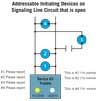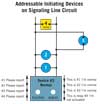
In today’s world, just about all fire alarm control units are created equal. What I mean by that is that the quality is comparable and similar controls have similar features. What may be different is the operating technology.
These controls (the correct terminology in NFPA 72 isfire alarm control unitor FACU) are basically split into two categories — addressable and conventional. Addressable systems can be further subdivided into straight addressable and analog-addressable, or “smart” panels. Most if not all addressable controls today are the analog type. Two other types of controls areemergency voice alarm communication(EVAC) panels anddigital alarm communicator transmitters(DACTS).
Today, fewer and fewer fire alarm installations use conventional control panels. They are mostly used for very small installations that do not have the need for all the addressable features.
Initiating devices connect to conventional panels usinginitiating device circuitsor IDCs. These circuits allow devices such as smoke detectors and manual pull stations to be connected by zone or area. If there is an alarm within that zone, someone must investigate the area to find out where the device in alarm is located. The panel does not tell you. You simply get a red LED indicating which zone was initiated. Most IDCs are two-wire circuits with an end-of-line resistor, providing power to two-wire smoke detectors as well as allowing alarm signals from actuated devices to be sent back to the panel. These circuits are supervised so that if a wire is removed from a device, or is shorted to ground, a trouble is reported to the panel. Similar to the alarm operation, the trouble is only indicated by zone, not by device.
The advantage of conventional fire alarm systems is that they are lower in cost than addressable systems. The non-addressable initiating devices connected to these panels are also less expensive. The disadvantages are lack of precise information for locating alarms or troubles and the inability to “t-tap” the wiring and maintain supervision. Another disadvantage is that if smoke detectors are installed, their sensitivity must be tested manually.

Non-addressable fire alarm circuits use Initiating Device Circuits or IDCs. Only devices between the control and the open would be able to operate on a Class B circuit.
Addressable Controls
Straight addressable control units are the most basic type. These controls date back to the early 1980s. Addressable initiating devices are connected to this control usingsignaling line circuitsor SLCs. This type of circuit allows many more devices than IDCs, provides precise information regarding which device is in alarm or supervisory mode, and provides better information to locate troubles on the circuit.This type of system does not allow the control to monitor the sensitivity of the smoke detectors. It simply reports which device is in alarm.
Analog-addressable controls, or smart systems, do allow sensitivity to be monitored and will provide notification if a smoke detector is outside its proper range. This is a good feature that will help reduce nuisance alarms before they happen. For instance, they will let you know when a detector is dirty so it can be cleaned before it starts to nuisance alarm.
The advantages of addressable fire alarm systems are many. Devices connected via the SLC will report alarm or trouble by device rather than just by zone. Wiring can be t-tapped and still maintain supervision. Input and output devices can both be connected to the same SLC. Devices can be added to this circuit with relative ease. An excellent example would be connecting smoke detectors and relays for elevator recall on a single SLC. Rather than running extra circuits to the elevator machine room for the relays, you simply connect them to the smoke detector circuit that is already in that room. You then program the relays to activate when one or more elevator lobby or machine room smoke detectors alarm.
The disadvantage of addressable systems is the higher cost. Addressable devices will cost more than non-addressable devices, but there is typically less wiring (and connections to be made), so labor costs are cheaper.
You may not think of an EVAC panel as a control panel, but that is exactly what it is. It is just used for a different purpose. Instead of connecting the initiating devices to the inputs and horns or strobes to the outputs, you use the EVAC panel to connect speakers to the system. The fire alarm control unit will be interconnected to the EVAC panel and will send signals to it to be used to determine which speaker circuits will be activated in the event of an alarm.
Emergency Voice Alarm Communication System
Emergency voice alarm communication systemsare required in certain occupancies, but can be used anytime. They are required in high rise buildings and primarily in largerassembly occupancies. The threshold occupancy load to require the use of an EVAC system is different in the International Building Code (occupant load over 1,000) and in the NFPA 101, Life Safety Code (over 300).Some fire alarm contractors use these in other occupancies as well. There is an advantage to using them ineducational occupanciesbecause the sound levels have a broader range of adjustment than by using horns.
They may also be used in occupancies like shopping malls. Again the codes differ in requirements. The IBC requires an EVAC system in a mall and allows it to be used for public announcements. NFPA 101 allows a public address (PA) system to be used for fire alarm usage by trained staff.
Digital Alarm Communicator Transmitter
Many people do not think of a DACT as a fire alarm control unit, but it is. Although there are some “slave” units, many used today are stand-alone controls that can accept inputs from either fire alarm initiating devices or the building fire alarm control unit. A good example of this would be a system that is only used for monitoring fire sprinkler systems.
Addressable fire alarm circuits use Signaling Line Circuits. An open will provide a trouble signal for all devices located after the open on a Class B circuit.
New definitions in NFPA 72, 2007 edition
The 2007 edition of NFPA 72 fire alarm code offers new definitions for fire alarm systems and control units in an attempt to reduce the number of misinterpretations of the code. For example, the code definesprotected premises fire alarm control unitas the panel that serves the whole building or a portion of the building. One very good example of why new definitions were required is when a fire alarm system is not required by code, but a supervised sprinkler system is. One interpretation today is that this is not a fire alarm system; it is a sprinkler supervisory system. The correct interpretation is that it is a fire alarm system for a specific purpose. So the new definition isdedicated function fire alarm systemand the control used would similarly be called adedicated function fire alarm control unit. So, this type of control would require protection by a smoke detector and a single manual fire alarm box. It would not require the installation of horns and strobes throughout the facility. Since the only requirement was for a supervised sprinkler system, the sprinkler section of the codes would determine if occupant notification is required or not.Another example of adedicated function fire alarm systemwould be a fire alarm control unit that is only installed as an “elevator control and supervisory panel.”
There are also better descriptions of which equipment must have smoke detectors protecting the control equipment. The 2007 code now clearly states that the fire alarm control units, notification appliance expander panels and digital alarm communicators must be protected by smoke detectors if installed in an area that is not constantly attended. A heat detector can be used if the environment is not suitable for a smoke detector.
An exception was added to the 2007 code allowing elimination of the smoke detector if the building is fully sprinklered. New Annex material better defines where this smoke detector is allowed to be installed. It states, “(1) Where the ceiling is 4.6 m (15 ft.) in height or less, the smoke detector should be located on the ceiling or the wall within 6.4 m (21 ft.) of the centerline of the fire alarm control unit being protected by the detector in accordance with 5.7.3.2.1. (2) Where the ceiling exceeds 4.6 m (15 ft.) in height, the automatic smoke detector should be installed on the wall above and within 1.8 m (6 ft.) from the top of the control unit.” This should clarify many questions that arise about protecting the fire alarm controls.

Addressable fire alarm circuits can have both input and output devices connected to the Signaling Line Circuit.
UL 864, Ninth edition
The Ninth Edition of UL 864, “Standard for Control Units and Accessories for Fire Alarm Systems,” will take effect on June 30, 2007. This edition is the first major revision of this UL Standard in nine years.Some of the changes in UL 864 simply keep this standard consistent with the latest requirements of NFPA 72. For example, in the 2002 edition of NFPA 72, the maximum time allowed for a fire alarm system to respond to an alarm signal decreased from 90 seconds to 10 seconds.
One of the major changes to the Ninth Edition has to do withnotification appliance circuits. One goal of this edition was to make the method of determining current draw consistent for all manufacturers. A key concern has to do with the amount of inrush current that may be applied to the circuit.
In the Ninth Edition, notification appliance circuits will either beregulated or special application. Appliances used with regulated circuits will have to be listed with that control. You will be able to install special application appliances on these circuits, but the number of appliances will have to be reduced by about 50 percent. This has a potential impact on replacements of existing systems. For example, if a control gets damaged by lightning and must be replaced, consideration must be given to the type of circuits the new control will have, regulated or special application, and the type of notification appliances currently installed in the facility to ensure they are compatible.